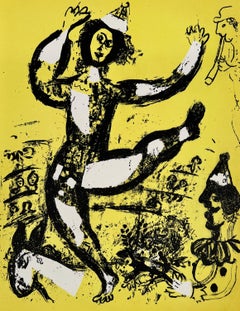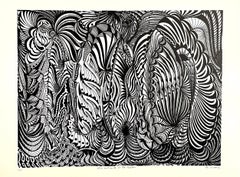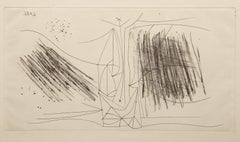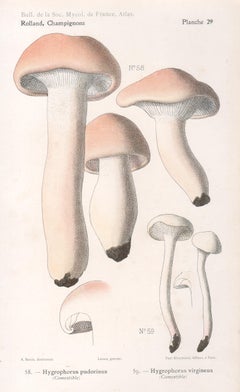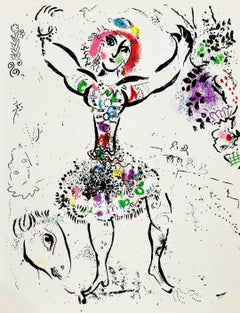20th Century More Prints
to
773
1,457
962
1,282
497
307
Overall Width
to
Overall Height
to
1,071
612
545
512
259
80
73
62
22
20
17
14
4
265
229
166
89
70
246
513
4,505
2,984
28
56
69
116
229
348
904
1,030
565
368
180
3,234
1,147
108
150
97
91
81
54
54
43
37
34
32
26
23
17
11
9
8
7
7
7
7
2,446
613
541
436
263
506
1,173
2,088
2,081
Period: 20th Century
Hommage a Amelia... Contemporary figurative Print, Pop art, Art deco, Polish art
Located in Warsaw, PL
Contemporary print on paper by Polish artist Danuta Dabrowska-Siemaszkiewicz. Artist is inspired by 20th century culture, art deco and pop culture. This artwork depicts portrait of A...
Category
Other Art Style 20th Century More Prints
Materials
Paper, Screen
Le cirque
By Marc Chagall
Located in OPOLE, PL
Marc Chagall (1887-1985) - Le cirque
Original Lithograph from 1960.
Dimensions of work: 32 x 24 cm.
Publisher: Maeght Éditeur, Paris.
The work is in Excellent condition.
Category
Modern 20th Century More Prints
Materials
Lithograph
Large 1960s French Art Brut Lithograph Bold Black & White Op Art Philippe Dereux
Located in Surfside, FL
Printed by Pierre Chave, Vence, published by Bianchi Frères in Nice, France
ink on watermarked chiffon de Mandeure paper, hand signed in pencil lower right, "PH Dureux," numbered 4/5...
Category
Outsider Art 20th Century More Prints
Materials
Archival Paper, Lithograph
Un Poème dans chaque Livre
Located in New York, NY
A very good impression of this drypoint on Japon ancien. Dated in the plate. Printed by Lacourière, Paris. Published by Louis Broder, Paris. From the same-titled suite.
Catalogue r...
Category
Abstract 20th Century More Prints
Materials
Drypoint
Champignons, French antique mushroom fungi chromolithograph, 1910
Located in Melbourne, Victoria
'58. Hygrophorus pudorinus 59. Hygrophorus virgineus'
Antique French mushroom / fungi chromolithograph.
From "Atlas des champignons de France, Suisse et Belgique," an atlas of Fren...
Category
Naturalistic 20th Century More Prints
Materials
Lithograph
The Juggler
By Marc Chagall
Located in OPOLE, PL
Marc Chagall (1887-1985) - The Juggler
Original Lithograph from 1960.
Dimensions of work: 32 x 24 cm.
Publisher: Maeght Éditeur, Paris.
The work is in Excellent condition.
Category
Modern 20th Century More Prints
Materials
Lithograph
Et Sur la Terre...
By Marc Chagall
Located in OPOLE, PL
MARC CHAGALL (1887–1985)
André Malraux, Et Sur la Terre...
A complete artist's book from 1977, printed on BFK Rives wove paper. It includes 15 etchings with aquatint, along with the...
Category
Symbolist 20th Century More Prints
Materials
Lithograph
$11,022 Sale Price
20% Off
Florentine
Located in London, GB
Linocut on Daragnès paper, Edition of 25
Paper size: 52 x 33 cms (20 1/2 x 13 ins)
image size: 18.5 x 14.3 cms (7 5/8 x 5 5/8 ins)
Category
Impressionist 20th Century More Prints
Materials
Linocut
'Poolside Pairs' Slim Aarons Limited Edition Estate Stamped Print
By Slim Aarons
Located in London, GB
'Poolside Pairs' Slim Aarons Limited Edition Estate Stamped Print, Printed Later
Former fashion model Helen Dzo Dzo Kaptur (in white lace) and Nelda Linsk (in yellow), wife of art d...
Category
Modern 20th Century More Prints
Materials
Color, Archival Pigment
Paul Jenkins - Composition - Original Lithograph
By Paul Jenkins
Located in Collonge Bellerive, Geneve, CH
Paul Jenkins - Composition - Original Lithograph
1964
Dimensions: 30 x 20 cm
Edition of 200 (one of the 200 on Vélin de Rives)
Mourlot Press, 1964
Paul Jenkins, American (1923 - 2012)
Paul Jenkins, an artist originally associated with abstract expressionism, exhibits in his mature works a redefining of color, light and space on the canvas surface.
Born in Kansas City, Missouri in 1923, Jenkins worked as a teenager in a ceramics factory, where he was first exposed to color intensity and the creation of form. From age 14 to 18, he studied drawing and painting at the city's Art Institute.
Initially interested in drama, Jenkins received a fellowship to the Cleveland Playhouse, then continued his dramatic studies in Pittsburgh at the Drama School of the Carnegie Institute of Technology.
Deciding to become an artist, Jenkins moved to New York City in 1948 and studied at the Art Students League. During Jenkins's three years at the League, Yasuo Kuniyoshi and Morris Kantor were his influential instructors.
While Jenkins continued to live and paint in New York City, his personal explorations took a metaphysical turn, which would ultimately become dominant in his work.
P.D. Ouspensky's The Search of the Miracu/ous changed the artist's thoughts on human growth and limitations, while the Chinese I Ching, through its thematic emphasis on constant change, heightened his interest in flowing paint on canvas. Painting for Jenkins became an intuitive, almost mystical process. He commented, "I paint what God is to me."
In 1953, Jenkins traveled to Paris, where, a year later, he had his first one-man show. While working at the American Artists Center, he continued to experiment with flowing paints, pouring pigment in streams of various thicknesses, with white thin spills as linear overlays.
Jenkins's intent was to deny stasis and create a literal and metaphysical sense of dynamism, while maintaining a sense of unity. Beginning in 1958, Jenkins titled each canvas Phenomena, with additional identifying words. He believed the work to be descriptive of the discovery process inherent in each painting.
Paralleling his beliefs, the artist's paintings have undergone subtle but definite changes. Beginning in the early 1 960s, a shift of color saturation and exposure of the white areas gave Jenkins's canvases an enhanced feeling of illumination.
If Jenkins's technique is unorthodox, he is in many other ways a traditional artist. He works in an acrylic medium on traditional linen canvas or fine rag paper. Often he uses an ivory knife...
Category
Modern 20th Century More Prints
Materials
Lithograph
The old hippie, from The Hippies
Located in Washington, DC
Artist: Salvador Dali
Title: The old hippie
Portfolio: The Hippies
Medium: Color etching on Arches wove paper
Date: 1969
Edition: 67/145
Frame Size: 31"...
Category
Surrealist 20th Century More Prints
Materials
Etching
Woman - Lithograph by Jacques Pecnard - Mid-20th Century
Located in Roma, IT
Woman is an original lithograph realized by Jacques Pecnard in the Mid-20th Century.
Good conditions.
The artwork is depicted through harmonious colo...
Category
Modern 20th Century More Prints
Materials
Lithograph
The Taste of Happiness, Planche XXXV
Located in OPOLE, PL
Pablo Picasso (1881-1973) - The Taste of Happiness, Planche XXXV
Lithograph from 1970.
An unsigned and unnumbered edition of 666.
Dimensions of sheet: 32.5 x 25 cm
Dimensions in ...
Category
Modern 20th Century More Prints
Materials
Lithograph
Colorful Russian French Judaica Jewish Shtetl Wedding Lithograph Mourlot Paris
By Mane Katz
Located in Surfside, FL
Mane-Katz (1894-1962) Original Lithograph published by Andre Sauret, Monte Carlo, 1966, printed in France, by Mourlot. The ouvrage sheet is not included. this is from a limited editi...
Category
Modern 20th Century More Prints
Materials
Lithograph
Common Horehound (Marrubium vulgare, Linne), antique botanical plant lithograph
Located in Melbourne, Victoria
'Common Horehound (Marrubium vulgare, Linne)'
Colour lithograph, 1909.
Category
Naturalistic 20th Century More Prints
Materials
Lithograph
The Hell of Cruel Beauties - Etching and Drypoint - 1972
Located in Roma, IT
The Hell of Cruel Beauties is a contemporary artwork realized in 1972.
Etching and drypoint on watermarked paper Chiffon de la Dore, (image cm 18x13; sheet cm 31x45)
Hand signed an...
Category
Surrealist 20th Century More Prints
Materials
Etching
Bi-Plane, Photorealist Screenprint by Ted Wilbur
Located in Long Island City, NY
Ted Wilbur, American (1930 - 2019) - Bi-Plane, Year: 1981, Medium: Screenprint, signed and numbered in pencil, Edition: 250, Size: 22 in. x 26 in. (55.88 cm x 66.04 cm)
Category
Photorealist 20th Century More Prints
Materials
Screen
Louisiana. USA Century Atlas state antique vintage map
Located in Melbourne, Victoria
'The Century Atlas. Louisiana'
Inset map of 'New Orleans and Vicinity'.
Original antique map, 1903.
Central fold as issued. Map name and number printed on the reverse corners.
Shee...
Category
Victorian 20th Century More Prints
Materials
Lithograph
Forest - Original Etching by Henri Farge - 20th century
Located in Roma, IT
Forest is a beautiful etching artwork realized by the French artist Henri Farge (1884-1970). Hand-signed on the lower right.
The state of preservation is ...
Category
Modern 20th Century More Prints
Materials
Etching
Los Angeles Summer Games 1984, Vintage Poster
Located in Pasadena, CA
This vintage poster from 1984, designed by doll historians Stéphanie Farago and Bob Dennison, features seven Lenci dolls in a setting related to the 1984 Summer Olympic Games in Los Angeles.
The image plays on mimicry: dolls imitating children, children dressed as adults, and adults observing them.
These iconic dolls, made of pressed felt by the Lenci company in the early 20th century, are dressed in adult sports attire: boxing gloves, jockeys, golfers' uniforms, riding jackets, and fencing gear. Their gaze is turned sideways, not toward each other or the viewer, but offstage. This sidelong glance, detached and unreadable, is the hallmark of Lenci's design and one of its earliest formal signatures.
Dressed for adult games, but motionless, they do not play—they pose, returning to their status as objects. The poster unsettles by staging this discrepancy between the theatricality of adult roles and the inert form of the doll. What should remain two-dimensional takes on unexpected volume, as if the viewer were reanimating a fragment of childhood.
The image, likely tied to Farago and Dennison’s 1986 publication "The Magic Romance of Art Dolls", presents the quintessential Lenci figure...
Category
Pop Art 20th Century More Prints
Materials
Offset
Women Outside Breton Hotel - Chromolithograph on Paper
Located in Soquel, CA
Women Outside Breton Hotel - Chromolithograph on Paper
In a pastel palette, Alson Skinner Clark (American, 1876-1949) captures the rustic beauty of a side street in a Breton village as two women converse outside of a hotel on a blue sky day.
Signed “Alson Clark...
Category
American Impressionist 20th Century More Prints
Materials
Laid Paper, Lithograph
WARRENPOINT AND THE MOUNTAINS (Ireland) original travel poster
By Margaret Horder
Located in Spokane, WA
WARRENPOINT AND THE MOUNTAINS of MOURNE, horizontal stone lithograph. Printer: J.B. Stephens. Professional acid-free archival linen-backed, ready to frame.
B condition image with only minor wear on the 1/2" cream outer border and a horizontal tear that was repaired during linen backing (shown in image #7). The last document copy of this poster was sold in 2021 on 1st dibs for $4518. Rare Irish Railway (railroad) lithograph poster.
Warrenpoint is a small, but beautiful town in County Down, Ireland. The hamlet itself is situated on the shores of Carlingford Lough...
Category
Art Deco 20th Century More Prints
Materials
Lithograph
$3,080 Sale Price
20% Off
Lovers by Corita Kent (Sister Mary Corita) (INV# NP3218)
By Corita Kent
Located in Morton Grove, IL
Corita Kent
Lovers
Serigraph Print
Image: 4.88 x 9"
Frame:11.75 x 15.75 x .75"
1983
Signed in pencil and numbered to lower edge ‘ed 200 Corita’
Category
Contemporary 20th Century More Prints
Materials
Screen
The Taste of Happiness, Planche LXIII
Located in OPOLE, PL
Pablo Picasso (1881-1973) - The Taste of Happiness, Planche LXIII
Lithograph from 1970.
An unsigned and unnumbered edition of 666.
Dimensions of sheet: 32.5 x 25 cm
Dimensions in...
Category
Modern 20th Century More Prints
Materials
Lithograph
The Creation of Things - Lithograph - 1964
Located in Roma, IT
The Creation of Things is a Color lithograph on heavy rag paper realized in 1964. It is part of Biblia Sacra vulgatæ edition is published by Rizzoli-Mediolani between 1967 and 1969.
...
Category
Surrealist 20th Century More Prints
Materials
Lithograph
$451 Sale Price
35% Off
The Taste of Happiness, Planche LVII
Located in OPOLE, PL
Pablo Picasso (1881-1973) - The Taste of Happiness, Planche LVII
Lithograph from 1970.
An unsigned and unnumbered edition of 666.
Dimensions of sheet: 32.5 x 25 cm
Dimensions in ...
Category
Modern 20th Century More Prints
Materials
Lithograph
Remember Belgium Buy Bonds Fourth Liberty Loan original WW1 vintage poster
Located in Spokane, WA
Original vintage poster”. Remember Belgium, Buy Bonds Fourth Liberty Loan. Mounted on acid free archival linen. Ready to frame. Over 100 years old!
This original World War 1 poste presents well, but the fold marks have been restored during the linen backing process.
The occupation of Belgium was a major propaganda theme of the First World War. There were horror stories of how the civilian population was treated and, true or not, they became fodder for the persuasion machine that was created to stir up the populace for a variety of causes, most having to do with raising money via bond issues. This especially powerful and frightening image, was created by Ellsworth Young...
Category
American Impressionist 20th Century More Prints
Materials
Lithograph
Vintage Poster after Alexander Calder - 1970s
Located in Roma, IT
Calder Fleches is a a vintage poster realized after Alexander Calder in the 1970s.
Colour lithograph on paper. Not signed
Published by Galerie Maeght,...
Category
Contemporary 20th Century More Prints
Materials
Lithograph
$503 Sale Price
30% Off
Faune et fuemme nue
Located in OPOLE, PL
Pablo Picasso (1881-1973) - Faune et fuemme nue
Lithograph from 1967.
The edition of 29/500 on Auvergne Richard de Bas paper.
With two watermarks - one of the paper, second of the...
Category
Modern 20th Century More Prints
Materials
Lithograph
Composition abstraite
By Chu Teh-Chun
Located in OPOLE, PL
Chu Teh-Chun (1920-2014) - Composition abstraite
Lithograph from 1960.
Edition 60/60.
Dimensions of work: 63.5 x 48.5 cm.
Hand signed.
Publisher: Galerie de France, Paris.
Dime...
Category
Modern 20th Century More Prints
Materials
Lithograph
Original 'Pull down your shades!" vintage war time poster.
Located in Spokane, WA
Original Pull down your shades! Rare original World War II poster. Save up to 10% on fuel. Isn't that the truth. Created for the U. S. Government Window Shade Institute. The original poster issued by the US Government. The purchase comes with a certificate of authenticity. Conservation linen backed and ready to frame. Very good condition with original U.S. Government issued poster fold marks restored.
The poster indicates that 30% of all heat loss is through windows. Your cloth window shades...
Category
American Realist 20th Century More Prints
Materials
Offset
$340 Sale Price
20% Off
Tribute to Michelangelo - Lithograph by Paul Wunderlich - 1975
Located in Roma, IT
Tribute to Michelangelo is an abstract color etching realized by the German artist Paul Wunderlich (Eberswalde, 1927 - Saint-Pierre-de-Vassols, 2010) in 1975.
Signed in pencil on th...
Category
Surrealist 20th Century More Prints
Materials
Lithograph
California, Northern Part. USA Century Atlas state antique vintage map
Located in Melbourne, Victoria
'The Century Atlas. California, Northern Part'
Inset maps of 'Yosemite Valley' and 'San Francisco and Vicinity'.
Original antique map, 1903.
Central fold as issued. Map name and nu...
Category
Victorian 20th Century More Prints
Materials
Lithograph
The Purgatory, Canto 12 - The Beauty of Sculptures
Located in OPOLE, PL
Salvador Dali (1904-1989) - The Purgatory, Canto 12 - The Beauty of Sculptures
Woodcut print from 1960.
Dimensions of work: 33 x 26.2 cm
Publisher: Les Heures Claires, Paris.
The...
Category
Surrealist 20th Century More Prints
Materials
Lithograph
'Fougasse' Careless Talk Costs Lives Cyril Kenneth Bird World War 2 poster
Located in London, GB
To see our other original vintage public information posters, scroll down to "More from this Seller" and below it click on "See all from this seller" - or send us a message if you ca...
Category
Modern 20th Century More Prints
Materials
Lithograph
Original "Men Working Together" vintage 1942 poster horizontal WWII
Located in Spokane, WA
Original World War II poster: "Men Working Together", horizontal original American World War II antique vintage military poster. Size 40" x 30". Year:...
Category
American Realist 20th Century More Prints
Materials
Offset
$560 Sale Price
20% Off
Hard Margins - Lithograph - 1964
Located in Roma, IT
La divina Commedia - Hard Margins is a Color Wood-cut on heavy rag paper realized in 1964. It is part of Biblia Sacra vulgatæ edition is published by Rizzoli-Mediolani between 1967 a...
Category
Surrealist 20th Century More Prints
Materials
Lithograph
$285 Sale Price
30% Off
Original 'Victory Loan Victory - now you can invest in it!' vintage poster
Located in Spokane, WA
Original WWII poster: VICTORY - NOW YOU CAN INVEST IN IT! VICTORY LOAN. Linen-backed in very good condition. Restored 'original' fold marks during linen backing which are not ...
Category
American Realist 20th Century More Prints
Materials
Offset
Original Philips Infra-Rouge vintage poster linen-backed
Located in Spokane, WA
Original Philips Infra-Rouge vintage poster. Size: 23" x 31". Archival linen-backed French antique poster. It is archival linen backed and ready to frame.
This fun kitchen poster...
Category
American Modern 20th Century More Prints
Materials
Lithograph
$311 Sale Price
20% Off
Monthlery 1931. Contemporary figurative Print, Pop art, Art deco, Polish art
Located in Warsaw, PL
Contemporary print on paper by Polish artist Danuta Dabrowska-Siemaszkiewicz. Artist is inspired by 20th century culture, art deco and pop culture. This artwork depicts a woman drivi...
Category
Other Art Style 20th Century More Prints
Materials
Paper, Screen
Act II, Scene III From Romeo and Julie-Lithograph -1975
Located in Roma, IT
Act II, Scene III - From “Romeo and Juliet” is an artwork realized by Salvador Dalí in 1975.
Mixed colored lithograph.
Signed and dated on plate on the lower...
Category
Surrealist 20th Century More Prints
Materials
Lithograph
South Dakota. USA. Century Atlas state antique vintage map
Located in Melbourne, Victoria
'The Century Atlas. South Dakota.'
Original antique map, 1903.
Central fold as issued. Map name and number printed on the reverse corners.
Sheet 29.5cm ...
Category
Victorian 20th Century More Prints
Materials
Lithograph
The Purgatory, Canto 23 - Gluttony
Located in OPOLE, PL
Salvador Dali (1904-1989) - The Purgatory, Canto 23 - Gluttony
Woodcut print from 1960.
Dimensions of work: 33 x 26.2 cm
Publisher: Les Heures Claires, Paris.
The work is in Exce...
Category
Surrealist 20th Century More Prints
Materials
Lithograph
"When the Word is LOVE (Book of LOVE)" silkscreen print by Robert Indiana
Located in Boca Raton, FL
"When the Word is LOVE (Book of LOVE)" silkscreen print from a portfolio of 12 original poems and 12 original prints by artist Robert Indiana. Edition 58/200. The prints in the portf...
Category
Contemporary 20th Century More Prints
Materials
Paper, Screen
And in those dayes, when Moses was growen... - The Exodus
By Marc Chagall
Located in OPOLE, PL
This work will be exhibited at Art on Paper NYC, September 4–7, 2025.
–-
Marc Chagall (1887-1985) - And in those dayes, when Moses was growen, he went foorth unto his brethren, and...
Category
Symbolist 20th Century More Prints
Materials
Lithograph
Original Algeciras Feria 1948 vintage Spanish travel lithograph poster
Located in Spokane, WA
Original vintage poster Algeciras Feria 1948 vintage Spanish travel poster. Archival linen backed in very fine condition, ready to frame. N...
Category
American Modern 20th Century More Prints
Materials
Lithograph
Homme couché et femme assise
Located in OPOLE, PL
Pablo Picasso (1881-1973) - Homme couché et femme assise
Lithograph from 1967.
The edition of 29/500 on Auvergne Richard de Bas paper.
With two watermarks - one of the paper, seco...
Category
Modern 20th Century More Prints
Materials
Lithograph
$2,396 Sale Price
20% Off
Original "RADIO L. M. T. La Meilleure Tonalite" vintage French radio poster
Located in Spokane, WA
Original poster: Radio L.M.T. "La Meilleure Tonalite". Elle l'aime tant.
French antique vintage poster for the L. M. T. Radio. The radio wit...
Category
American Modern 20th Century More Prints
Materials
Lithograph
The Blasphermers - Woodcut print - 1963
Located in Roma, IT
The Blasphermers - Hell Plate 14 is a woodcut print realized in 1963 for a series illustrating the Medieval poem of the "Divine Comedy" by Dante Alighieri. Plate n.32 (as reported on...
Category
Surrealist 20th Century More Prints
Materials
Woodcut
The Paradise, Canto 12 - L'Eclat des corps glorieux
Located in OPOLE, PL
Salvador Dali (1904-1989) - The Paradise, Canto 12 - L'Eclat des corps glorieux
Woodcut print from 1960.
Dimensions of work: 33 x 26.2 cm
Publisher: Les Heures Claires, Paris.
Th...
Category
Surrealist 20th Century More Prints
Materials
Lithograph
1971 "Ein Domberger Siebdruck-Kalender" Max Bill Silkscreen
By Max Bill
Located in Arp, TX
Max Bill
"Primary Colors"
1971
Silkscreen on paper edition of 2375
"Ein Domberger Siebdruck-Kalender"
11.75"x14" unframed
Unsigned
Born in Switzerland, Max Bill was an artist widely...
Category
Abstract 20th Century More Prints
Materials
Paper, Screen
Original "Diane" vintage 1/2 sheet movie poster Lana Turner, Roger Moore
Located in Spokane, WA
Title: Original "Diane" 1956 Half-Sheet Vintage Movie Poster Linen backed and ready to frame. NSS: 56/13
Features:-
- This is an original movie poster for the 1956 film "Diane"...
Category
American Modern 20th Century More Prints
Materials
Offset
$238 Sale Price
20% Off
Le Tour Eiffel, Modern Etching with Aquatint by Charles Martin
Located in Long Island City, NY
Le Tour Eiffel
Charles Martin, French (1884–1934)
Date: 1927
Etching with Aquatint on BFK Rives
Image Size: 7.75 x 5.5 inches
Size: 12.75 x 9.75 in. (32.39 x 24.77 cm)
Category
Modern 20th Century More Prints
Materials
Etching, Aquatint
Champignons, French antique mushroom truffle fungi chromolithograph, 1910
Located in Melbourne, Victoria
'279. Bulgaria inquinans 280. Elaphomyces variegatus 281. Xylaria hypoxylon 282. Tuber melanosporum (Truffle) 283. Tuber aestivum (Summer truffle)'
Antique French mushroom / fungi c...
Category
Naturalistic 20th Century More Prints
Materials
Lithograph
Soviet Posters 1978 Success Through Work Russian Motifs
Located in London, GB
To see more, scroll down to "More from this Seller" and below it click on "See all from this Seller."
Orlov, V and Denisenko
За успехи в труде [Success Through Work] (1978)
Moscow,...
Category
Modern 20th Century More Prints
Materials
Lithograph
The Taste of Happiness, Planche XXIII
Located in OPOLE, PL
Pablo Picasso (1881-1973) - The Taste of Happiness, Planche XXIII
Lithograph from 1970.
An unsigned and unnumbered edition of 666.
Dimensions of sheet: 32.5 x 25 cm
Dimensions in...
Category
Modern 20th Century More Prints
Materials
Lithograph
Albero Provvisorio 1 - Etching by Leo Guida - 1995
By Leo Guida
Located in Roma, IT
Albero provvisorio 1 is an original Contemporary artwork realized in 1995 by the italian Contemporary artist Leo Guida (1992 - 2017).
Original mixed colored etching.
Hand sign...
Category
Contemporary 20th Century More Prints
Materials
Etching
Gestreckter Akt
Located in Kansas City, MO
Title: Gestreckter Akt
Medium: Etching
Edition: 50
Signed and numbered by hand
Size: 21.5 × 17.4 on 25.2 × 19.9 inches
COA provided
Claude Garache is a French artist. He has worked ...
Category
Abstract Impressionist 20th Century More Prints
Materials
Etching
"John Baldessari [Two Ships]"
Located in New York, NY
John Baldessari
"John Baldessari [Two Ships]"
Margo Leavin Gallery, Los Angeles, 1986
Exhibition Poster
18 x 24 inches
Unsigned
Category
Contemporary 20th Century More Prints
Materials
Offset
Pierre Bonnard Ltd Ed Lithograph Printed at Mourlot Paris 1958 Sail Boats, Lake
Located in Surfside, FL
This is from a limited edition portfolio of original lithographs print Fernand Mourlot in Paris in 1958 from work done in collaboration with Bonnard which began in 1928.
This is f...
Category
Post-Impressionist 20th Century More Prints
Materials
Lithograph
Recently Viewed
View AllMore Ways To Browse
Villard L
Vintage Boombox
Vintage Boxing Knockouts
Vintage Dior Bag Men
Vintage Fairground Posters
Vintage Horse Logging
Vives Maristany
Walford Painting
Walt Horton
Whitney Birch
Willi Bauer Oil Painting
William Beattie Brown
William Callow
William Krug
William Otto Emerson
Wyland Paintings
Yorkshire Terrier Oil Painting
Yvette Mimieux

